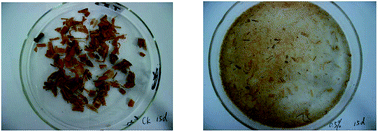Microbial consortium OEM1 cultivation for higher lignocellulose degradation and chlorophenol removal†
Abstract
Herein, microbial consortium OEM1 that could simultaneously decompose lignocellulose and chlorophenols was screened from spent mushroom substrates. Its degradation potential further needs to be confirmed by optimizing the culture conditions (such as organic loads, initial pH values, and cultivating ways). The results illustrated that 2.0% rice straw load provided highest organic degradation rate with OEM1. After 9 days of cultivation, O-chlorophenol (MCP), 2,4-dichlorophenol (2,4-DCP), and 2,4,6-trichlorophenol (2,4,6-TCP) were almost completely degraded. After 15 days, cellulose, hemicellulose, and lignin were degraded by 97.4%, 76.4%, and 69.8%, respectively. The mass loss of the rice straw could reach 66% when the initial pH value of the culture medium varied from 5.0 to 8.0. Moreover, higher degradation efficiencies in chlorophenols were obtained under neutral or alkaline condition. In addition, the degradation efficiency for lignocellulose and chlorophenol could reach 57.1% and 58.6%, respectively, with static cultivation.



 Please wait while we load your content...
Please wait while we load your content...